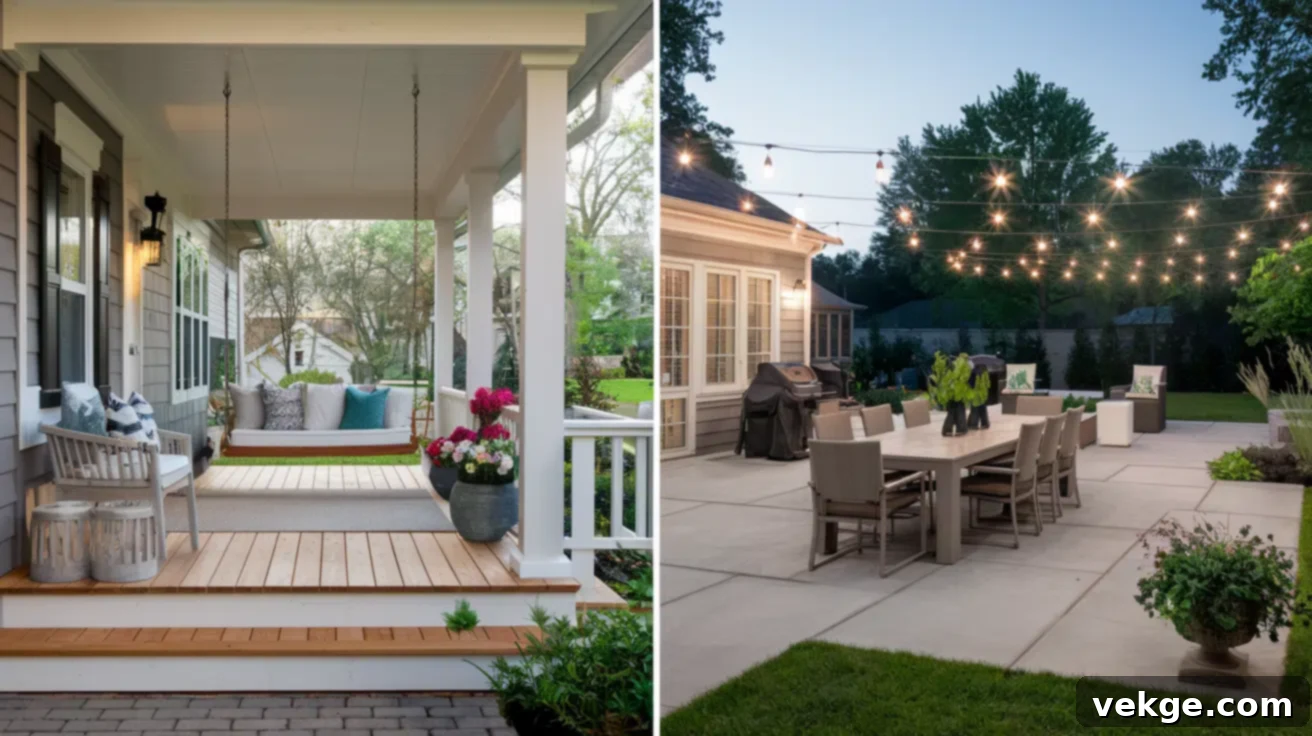Porch vs Patio: Discover the Differences, Design Ideas & Building Tips for Your Home’s Exterior
Are you envisioning an upgrade to your home’s outdoor living space? Whether your dream involves a tranquil porch for quiet relaxation or an expansive patio perfect for entertaining, the right design can profoundly enhance your home’s curb appeal and functionality. Creating an inviting outdoor area extends your living space, offers new opportunities for enjoyment, and significantly boosts your property’s value.
This comprehensive guide will walk you through the essential differences between porches and patios, explore their unique benefits, and spark your imagination with exciting design concepts. We’ll also cover crucial insights into construction, cost implications, and ongoing maintenance, equipping you with the knowledge to make the best decision for your home and lifestyle. Let’s explore how you can craft the ultimate outdoor retreat tailored just for you.
Understanding Porches and Patios: Defining Your Outdoor Oasis
Both porches and patios are fantastic additions that extend your home’s living area into the outdoors, yet they possess distinct characteristics in their structure, function, and placement. Grasping these fundamental differences is key to choosing the perfect outdoor space for your needs.
A porch is a covered outdoor structure, typically attached to the front or side of a house. It serves as a charming transitional zone, bridging the gap between your indoor sanctuary and the external world. Porches offer a sheltered spot, ideal for unwinding, welcoming guests, or simply enjoying the changing weather conditions without direct exposure. They can range from fully open designs to screened or even fully enclosed spaces, providing varying levels of protection and privacy.
In contrast, a patio is a flat, paved outdoor area, usually situated at ground level. Most commonly found in backyards or gardens, patios are exceptionally versatile, making them perfect for outdoor dining, lively entertaining, or various recreational activities. Their open-air design offers flexibility in layout and landscaping, allowing for a seamless integration with your garden and natural surroundings.
Patio vs. Porch: A Detailed Comparison of Key Differences
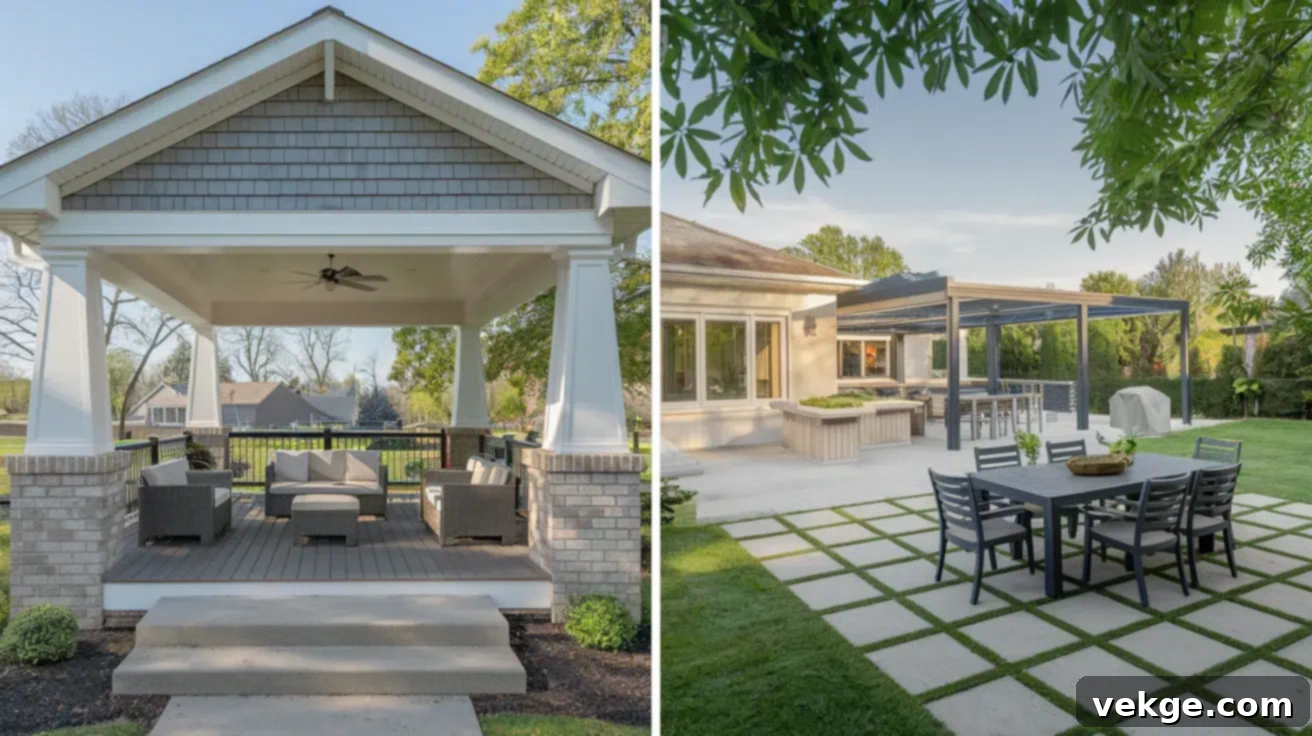
While both porches and patios enhance your outdoor living experience, their fundamental characteristics vary significantly. These differences, encompassing attachment, location, primary function, and type of covering, are crucial factors in determining which option best suits your home and personal preferences. A clear understanding will guide you toward making an informed decision.
Here’s a concise breakdown comparing porches and patios across various essential factors:
| Factor | Porch | Patio |
|---|---|---|
| Attachment to the House | Directly attached to the main house structure, often at the front entrance or side. | Typically a separate, ground-level hardscape structure, not physically connected to the house. |
| Location | Predominantly found at the front of the house, offering a welcoming facade; can also extend along the side. | Most commonly situated in the backyard or garden, prioritizing privacy and direct access to green spaces. |
| Primary Function | Serves as a sheltered and welcoming area for relaxation, social interaction, and greeting visitors, enhancing curb appeal. | A highly versatile space designed for diverse activities like outdoor dining, large-scale entertaining, and various recreational pursuits. |
| Covering | Almost always features a permanent roof, providing consistent shelter; can be further enhanced with screens or full enclosures. | Primarily open-air, but often incorporates partial or full overhead coverings such as pergolas, awnings, or shade sails for comfort. |
| Materials & Construction | Constructed from materials like wood, composite decking, or concrete, involving a more complex build with a foundation, framing, and a full roof structure. | Built using durable materials such as concrete, natural stone, pavers, brick, or gravel, requiring ground preparation, base laying, and surface installation. |
| Cost Considerations | Generally more expensive due to the intricate structural requirements including a robust foundation, roofing, framing, and often higher material costs. | Typically more budget-friendly, especially when opting for simpler materials like poured concrete, gravel, or basic pavers, making it a more accessible upgrade. | Maintenance Requirements | May demand more extensive upkeep due to roofing, painted or stained wooden components, and structural elements that need regular inspection. | Often easier to maintain, with requirements largely depending on the chosen materials; sweeping, occasional cleaning, and joint sand replenishment are common. |
Choosing the Best Option for Your Home: Porch or Patio?
When deciding between adding a porch or a patio, carefully weighing the distinct advantages of each is essential. Your choice will largely depend on your specific needs, the layout of your property, and your desired outdoor experience.
A porch significantly boosts your home’s curb appeal, instantly making it more inviting and charming. Its primary benefit is providing a sheltered space, offering protection from unpredictable weather like rain, direct sunlight, and even snow. This makes a porch an ideal spot for enjoying a morning coffee, greeting guests, or simply unwinding in a comfortable, protected environment. While porches are fantastic for creating a welcoming entrance, their fixed structure and typical front-of-house location might limit their flexibility for diverse activities or extensive customization compared to patios.
Conversely, patios offer unparalleled versatility. Their ground-level, open-air nature allows for endless design possibilities and adaptations to suit a wide array of activities, from intimate family dinners to lively parties or active recreation. Patios are easier to personalize and modify as your needs evolve, and their common placement in the backyard provides a greater sense of privacy and seclusion. From a cost perspective, while porches often involve a higher investment due to their structural complexity (foundations, roofs, framing), patios are generally more affordable to install, especially when using common materials like concrete, gravel, or simple pavers. Ultimately, the best choice hinges on your available outdoor space, your budget, and how you envision using your new outdoor area.
Inspiring Design and Customization Ideas for Your Outdoor Space
Beyond functionality, the design of your porch or patio plays a crucial role in enhancing your home’s aesthetic and creating an inviting atmosphere. Explore these creative design and customization options to ensure both style and function perfectly align with your outdoor living aspirations.
Porch Design Ideas: Elevate Your Home’s Entrance
Discover inspiring design ideas that will not only enhance the visual appeal of your porch but also boost its functionality, transforming it into a truly welcoming and comfortable outdoor extension of your home.
Classic Front Porch
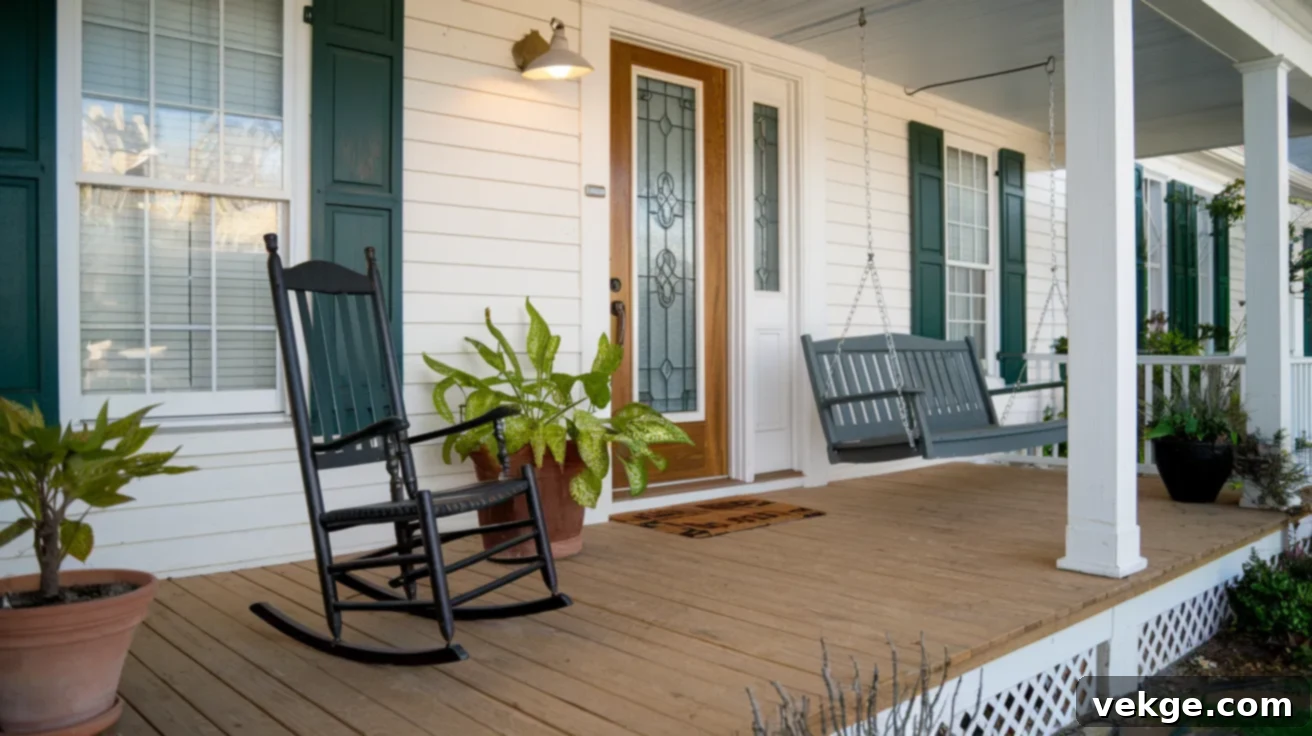
A well-designed front porch creates an immediate warm and inviting impression. Furnish it with comfortable seating, such as classic rocking chairs, a charming swing bench, or even a traditional porch swing, to encourage relaxation. Accentuate the space with soft, ambient lighting, vibrant potted plants, and a welcoming doormat. This combination not only sets a pleasant tone for visitors but also offers a peaceful personal retreat where you can enjoy the outdoors from the comfort of your home. Consider adding small side tables for drinks or books to complete the cozy setup.
Functional Screened-In Porch

A screened-in porch offers the best of both worlds: fresh air without the annoyance of insects, and an enhanced sense of privacy. This makes it an ideal choice for those who desire to fully embrace outdoor living while being protected from pests and unpredictable weather elements. Screens can be seamlessly integrated into existing porch structures or added as a thoughtful upgrade, significantly increasing the versatility of the space. A screened-in porch can easily function as an additional living area—perfect for al fresco dining, an afternoon reading nook, or a comfortable spot for entertaining friends and family, extending your home’s usable footprint.
Private Side Porch
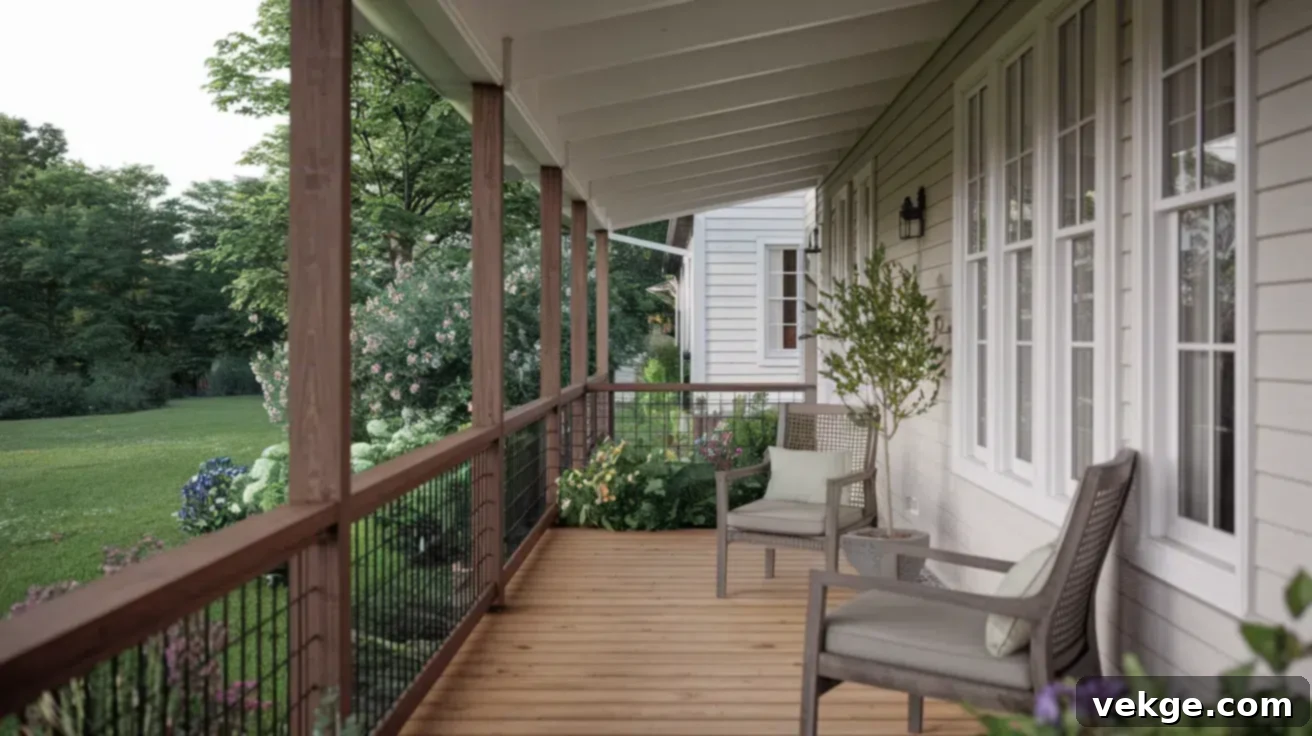
For those seeking a more secluded outdoor experience, a side porch provides an excellent alternative to a front porch. Tucked away from public view, it creates a private sanctuary for ultimate relaxation, reading, or enjoying meals in a more intimate setting. Design this space with plush, comfortable seating, abundant lush greenery, and perhaps a small outdoor dining set to cultivate a tranquil relaxation zone. A side porch is perfect for individuals or families looking to create a personal outdoor escape, a hidden gem where they can unwind away from the daily hustle and bustle, offering a unique blend of privacy and comfort.
Patio Design Ideas: Versatile Outdoor Living Spaces
Patios offer unparalleled flexibility for creating dynamic outdoor living areas perfect for dining, entertainment, and recreation. Here are some inspiring design ideas to transform your backyard into a functional and stylish extension of your home.
Expansive Backyard Patios
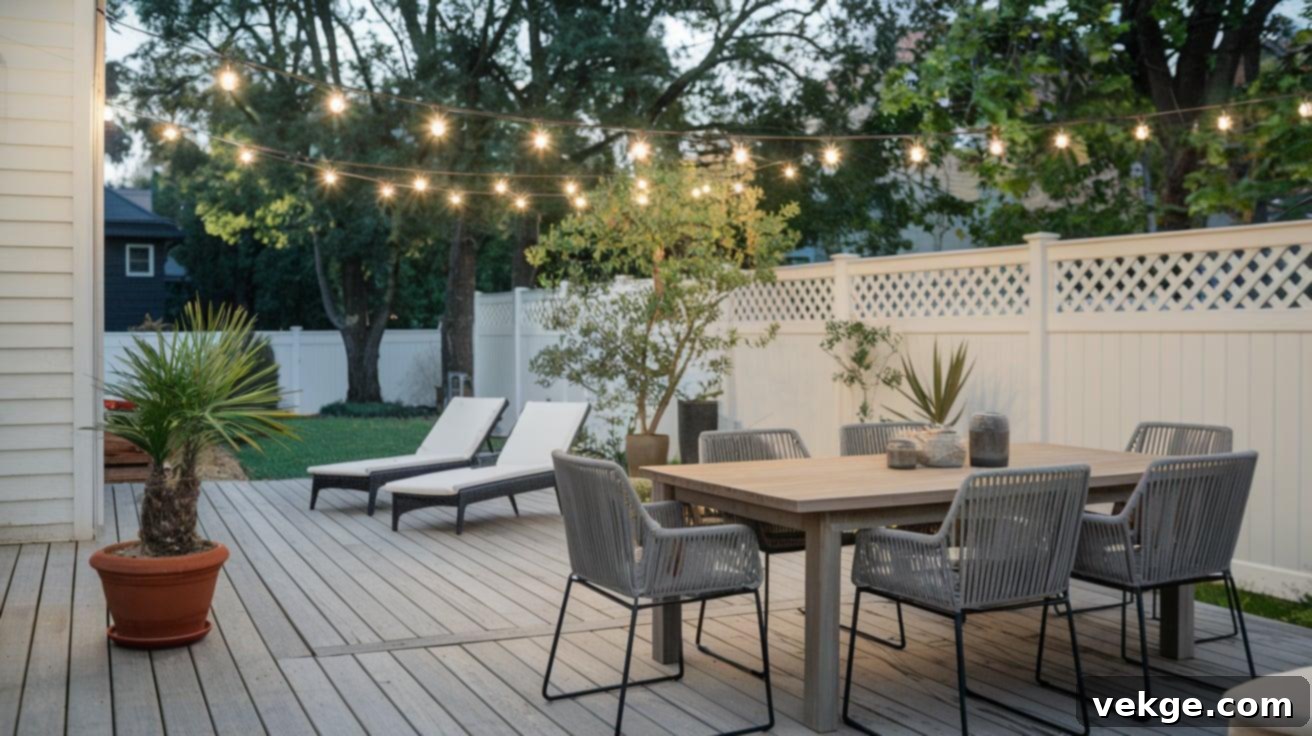
A backyard patio is the quintessential space for hosting unforgettable gatherings, enjoying delicious outdoor meals, or simply unwinding under the open sky. Focus on selecting comfortable, durable outdoor seating, such as inviting lounge chairs, plush outdoor sofas, or a full outdoor dining set for family-friendly functionality. This design can be effortlessly customized with strategic lighting solutions like string lights or lanterns, decorative planters brimming with vibrant foliage, or even a fully equipped outdoor kitchen area for ultimate convenience. Patios are incredibly adaptable, capable of transforming into a versatile hub for any activity you love, from intimate dinners to grand celebrations.
Comfortable Covered Patios
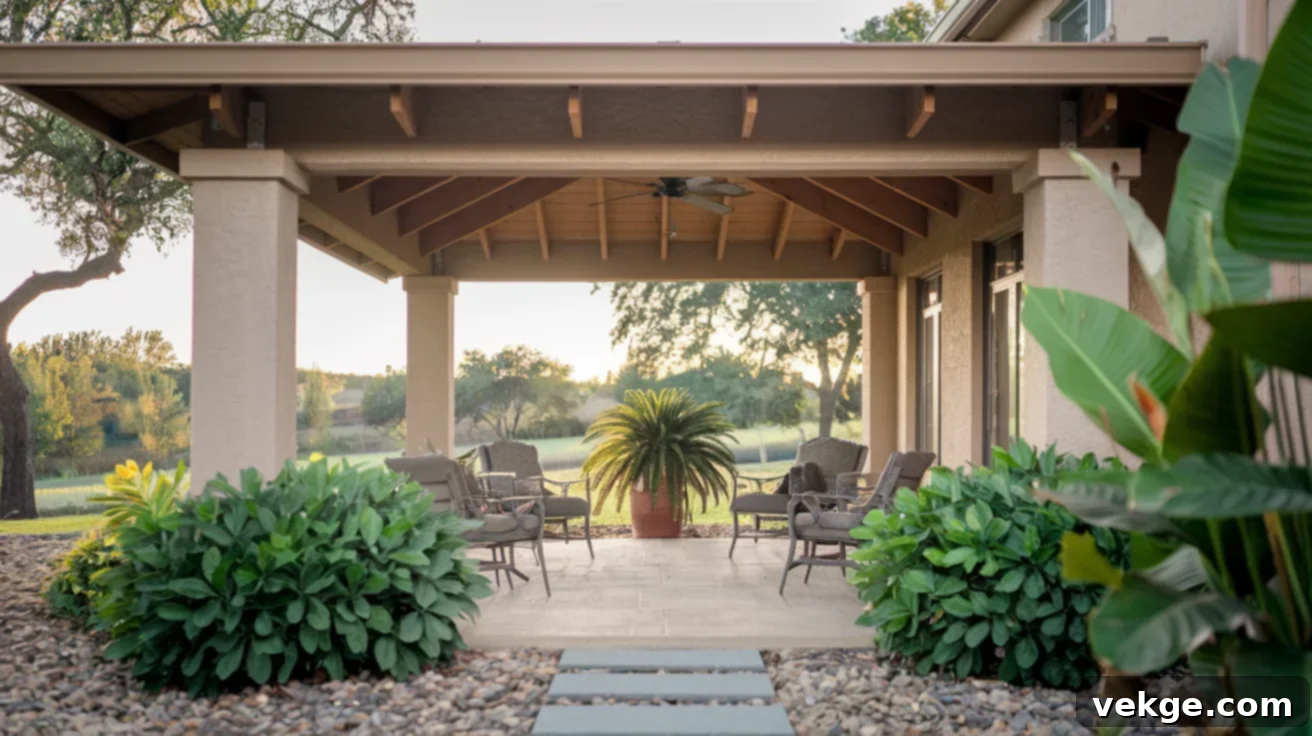
A covered patio provides invaluable protection from both intense sun and unexpected rain showers, making it ideal for year-round enjoyment. This setup offers a pleasant sense of intimacy and shelter, allowing you to comfortably enjoy the outdoors regardless of the weather conditions. Enhance a covered patio with practical amenities like ceiling fans for cooling breezes, elegant string lights for evening ambiance, or soft outdoor rugs to add warmth and define the space. Whether you opt for a permanently integrated roof or a flexible retractable covering, this design ensures your outdoor area remains a delightful and functional extension of your home throughout every season.
Cozy Fire Pit Patios
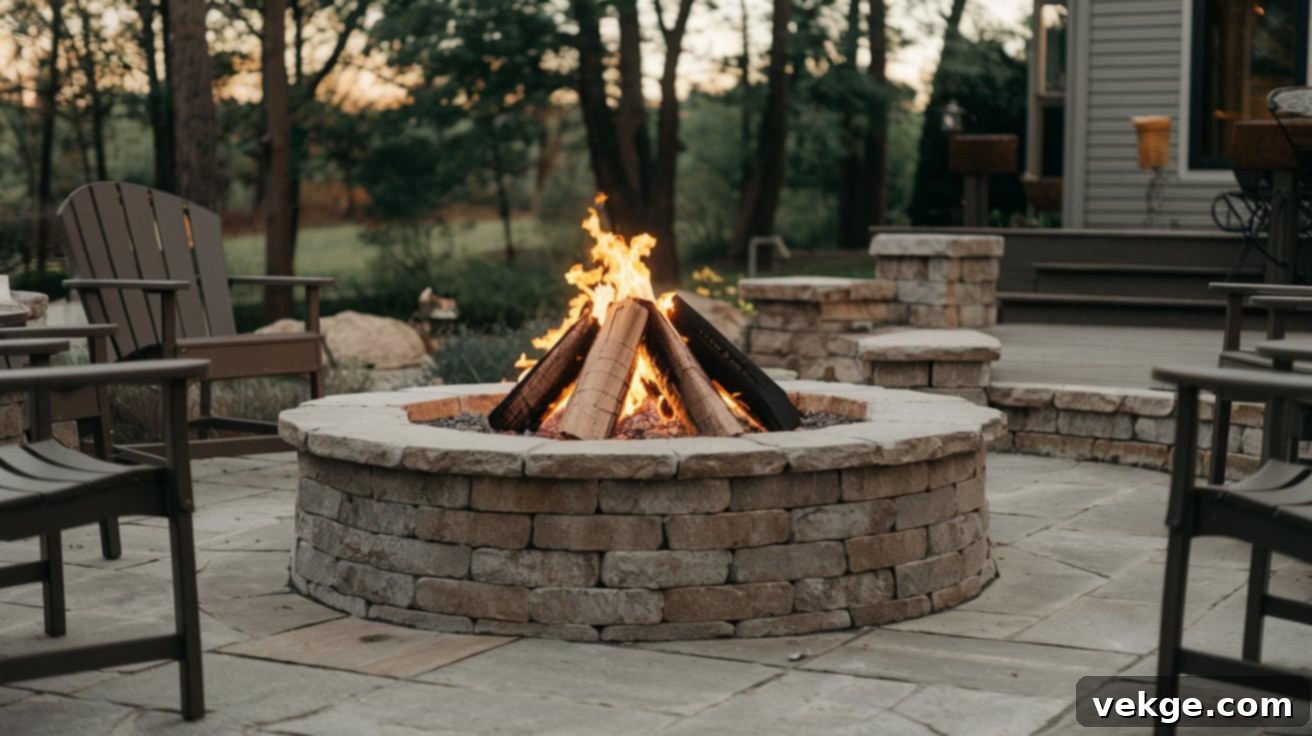
Incorporating a fire pit onto your patio instantly creates a warm, inviting, and utterly cozy atmosphere, perfect for enchanting evening entertainment. Arrange comfortable seating, such as deep-seated chairs or built-in benches, around the fire pit to foster a sense of intimacy and encourage conversation. This design is exceptionally popular for cooler nights, providing a natural gathering spot for friends and family to share stories, roast marshmallows, or simply bask in the mesmerizing glow of the flames. Integrate natural elements like stone, brick, or rustic wood into the fire pit’s design to ensure it blends seamlessly and beautifully into your overall outdoor landscape.
Climate-Based Design Tips for Optimal Enjoyment
Designing your porch or patio effectively means adapting it to your local climate. Each environment presents unique challenges and opportunities, and tailoring your space accordingly will ensure maximum comfort and longevity.
Cold Climates: For regions experiencing chilly temperatures, focus on designs that provide ample warmth and protection. Consider sheltered patios with windbreaks or even partially enclosed areas, and opt for fully enclosed porches or sunrooms. Insulated roofs, sturdy side walls, and even outdoor heaters or fireplaces can keep the cold at bay, allowing you to comfortably enjoy your outdoor space for more months of the year. Thoughtful landscaping with evergreen plants can also help block cold winds.
Hot Climates: In warmer climates, the priority shifts to creating cool, shaded, and airy spaces. Open patios are popular, but they should be strategically enhanced with effective cooling elements and robust shade structures. Install pergolas, large umbrellas, or retractable canopies to block direct sun. Incorporating ceiling fans, misting systems, or even water features can significantly lower ambient temperatures and enhance comfort during scorching summer days. Using light-colored materials for your patio surface can also help reflect heat.
Integrating Style with Home Design: A Seamless Transition
Your porch or patio should not only be functional but also aesthetically align with the architectural style of your home, creating a harmonious and cohesive look. Here’s how to blend your outdoor spaces seamlessly with your overall home aesthetic.
Outdoor Spaces for Modern Homes
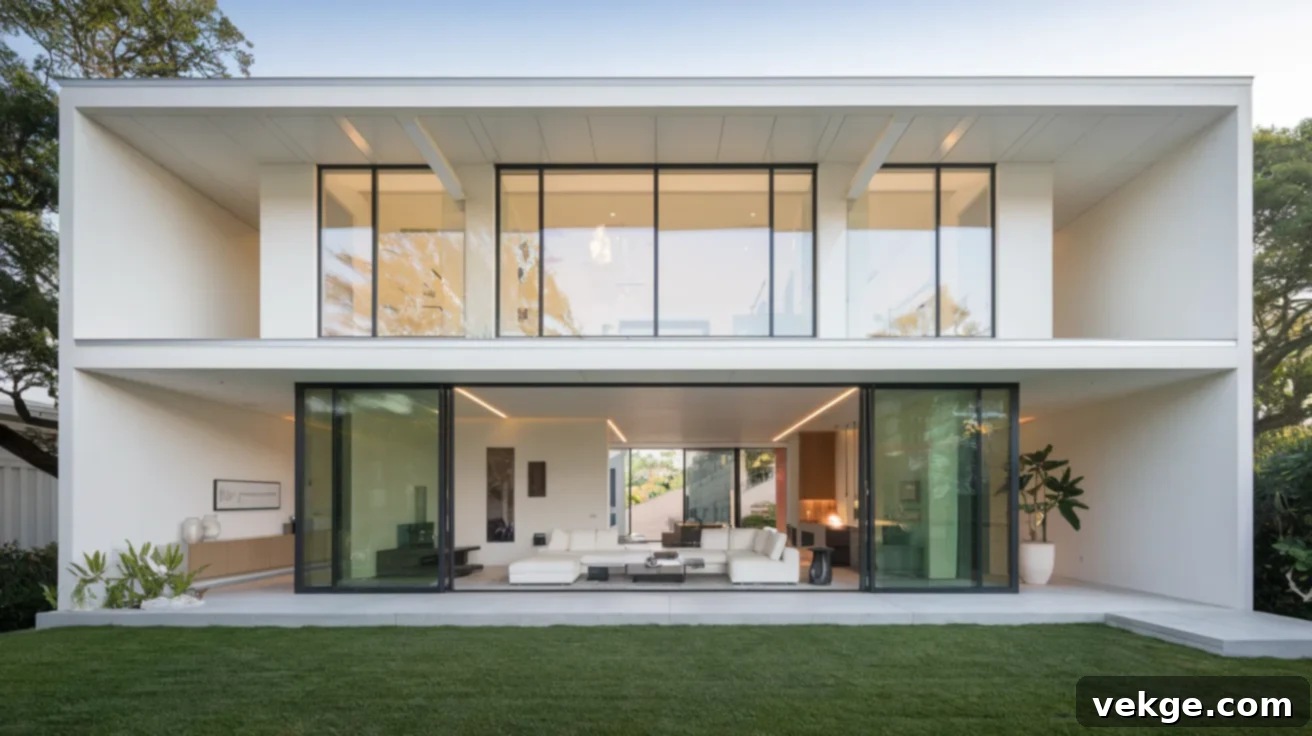
For homes boasting a modern architectural style, the outdoor spaces should mirror this aesthetic with sleek, minimalistic designs. Emphasize clean lines, geometric shapes, and a palette of neutral tones. Incorporate contemporary materials such as polished concrete, steel, glass, and composite decking. Keep the space uncluttered, focusing on simple yet functional furniture and integrated lighting. The design should align perfectly with the home’s existing contemporary features, ensuring a seamless visual flow from inside to out, creating an elegant and sophisticated outdoor extension.
Outdoor Spaces for Traditional Homes
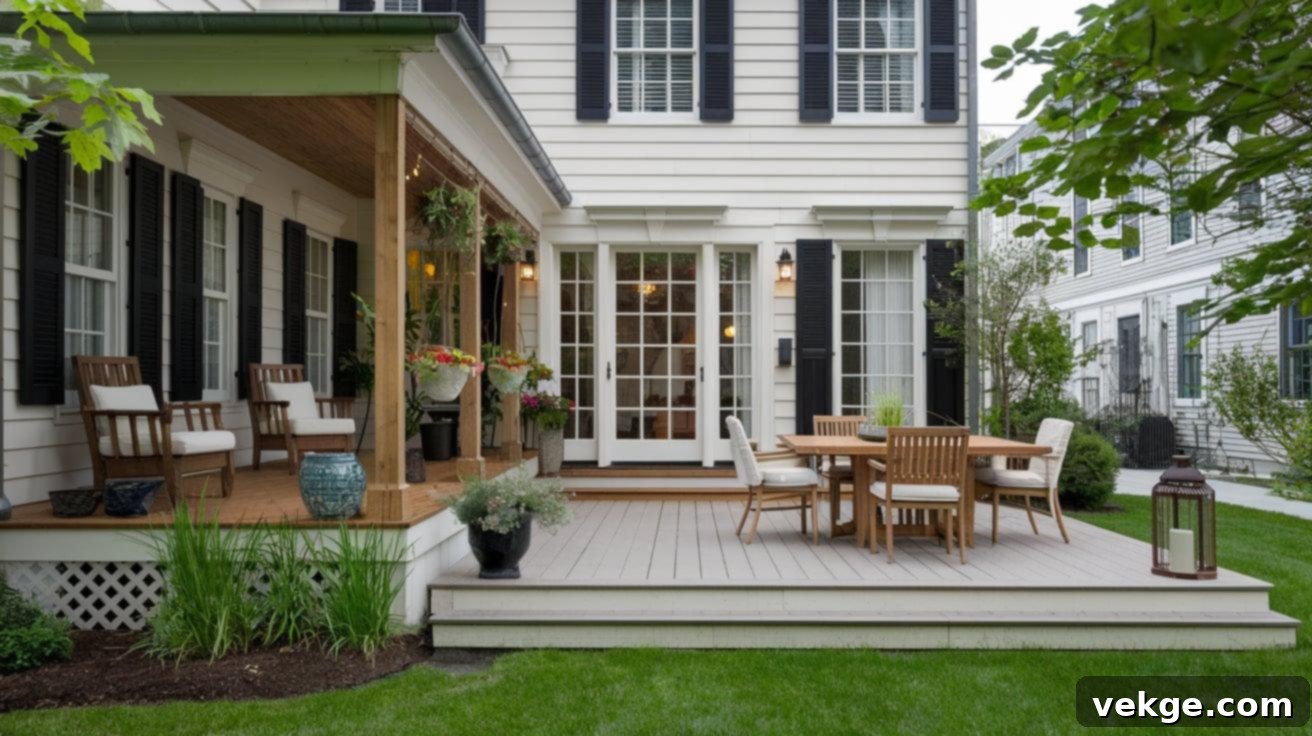
Traditional homes are beautifully complemented by classic wooden or brick porches, exuding timeless charm and warmth. For backyard spaces, a cozy patio featuring soft, inviting seating, natural materials like flagstone or pavers, and rustic accents works wonders. Think lanterns, cast iron decor, or a sturdy wooden dining set to echo the home’s classic appeal. Incorporate lush, traditional landscaping with flowering plants and mature shrubs to enhance the overall picturesque and harmonious aesthetic, creating an outdoor space that feels like it has always belonged.
Step-by-Step Guide to Building Your Dream Porch or Patio
Embarking on a porch or patio construction project requires meticulous planning and execution. Follow these detailed steps to ensure a durable, properly installed, and long-lasting outdoor space that you’ll enjoy for years to come.
I. Stepwise Guide to Building a Porch with a Tiled Roof
This comprehensive guide will lead you through the intricate process of constructing a sturdy porch with a durable tiled roof, covering everything from laying the foundation to applying the final finishing touches.
Step 1: Site Excavation and Preparation
Begin by carefully excavating the designated area for the porch footings. Ensure the ground is perfectly leveled and cleared of any debris, roots, or obstructions. Proper site preparation is fundamental for a stable and secure foundation.
Step 2: Setting the Foundation Levels
Utilize a laser level or other precise measurement tools to accurately set the footings at the correct height and alignment. This crucial step ensures that the new porch structure integrates seamlessly and perfectly aligns with your existing home’s architecture.
Step 3: Concrete Pour for Footings
Prepare your concrete mix. For smaller quantities, hand-mixing ensures optimal consistency. Pour the concrete carefully into the prepared foundation trenches, filling them evenly. Allow adequate time for the concrete to cure and harden completely before proceeding.
Step 4: Constructing the Walls
Once the concrete foundation is solid, begin laying the first course of blocks for the porch walls. For enhanced strength and improved energy efficiency, consider using insulated blocks. Maintain precision with levels and mortar thickness for a straight and robust wall structure.
Step 5: Installing Structural Steel Supports
Integrate steel supports into the wall structure as required. These reinforcements are vital for providing superior stability to the overall porch framework and are essential for safely bearing the substantial weight of the roof structure.
Step 6: Rafter Installation and Roof Tiling
Install the roof rafters, ensuring they are securely fastened and properly angled for drainage. Begin the process of laying the roof tiles, working systematically from the bottom up. Crucially, use step flashing around any intersecting walls to ensure thorough waterproofing and prevent leaks.
Step 7: Final Weatherproofing and Finishing Touches
Complete the porch construction by adding all necessary finishing touches, including flashing around edges and applying sealants. These steps are critical for effectively weatherproofing the porch, ensuring it is fully protected against moisture, wind, and other environmental elements for long-term durability.
Watch this video to see the full process of building a porch from start to finish, including valuable tips and techniques for a successful project.
II. Stepwise Guide to Building a Durable Patio
Learn professional techniques for constructing a robust and enduring patio. This guide covers every stage, from preparing the base to the final installation and long-term maintenance, ensuring a beautiful and stable result.
Step 1: Subbase Preparation and Compaction
Start by preparing the subbase, which is the underlying raw soil. Thoroughly compacting the subbase is paramount for creating a stable and solid foundation. This critical step prevents future issues like shifting or settling of your patio pavers, ensuring a long-lasting surface.
Step 2: Laying the Base Material
Once the subbase is compacted, introduce the base material. This layer acts as a vital separation between the subbase and your pavers. Class 5 material is highly recommended for its excellent cohesive properties, providing a strong and reliable foundation for your patio.
Step 3: Precision Sand Base (Screed Layer)
Lay your sand base, also known as the screed layer, with meticulous accuracy, ensuring it is precisely 1 inch deep. Maintaining this exact depth is crucial; an excessive amount of sand can lead to unwanted shifting and instability of the pavers over time, compromising the patio’s integrity.
Step 4: Paver Installation
Begin carefully laying the pavers according to your chosen design layout. For a “cutless” patio, strategically align your pavers to minimize or entirely eliminate the need for cutting. This approach not only simplifies the installation process but also significantly speeds up completion.
Step 5: Joint Sand Application and Compaction
Once all pavers are in place, evenly spread fine sand (often polymeric sand) over the joints. Use a broom to thoroughly sweep the sand into all the cracks. Then, compact the sand using a plate compactor to firmly lock the pavers in their position, enhancing stability.
Step 6: Finalizing Joint Compaction
Perform a final check to ensure all sand is properly and fully compacted into the paver joints. The more densely compacted the sand, the greater the stability of the patio, significantly reducing the likelihood of pavers shifting or loosening over time.
Step 7: Ongoing Maintenance for Longevity
Implement routine maintenance by sweeping in fresh sand into the joints annually. This simple yet effective practice helps maintain the patio’s solidity and prevents the need for extensive repairs if the polymeric sand starts to degrade. Consistent upkeep ensures your patio remains beautiful and functional for many years.
Now that you’ve completed the steps, watch this video to see the entire patio-building process in action for a clearer, more comprehensive understanding.
Common Mistakes to Avoid When Building a Porch or Patio
Constructing a new porch or patio is a significant home improvement project that requires careful planning and attention to detail. Steering clear of common pitfalls will ensure a successful and satisfying outcome. Here are crucial mistakes to avoid to ensure your project’s longevity and functionality:
- Ignoring Local Building Codes and Regulations: Failing to research and adhere to local building codes, permits, and homeowner association (HOA) rules can lead to costly fines, mandatory deconstruction, or significant delays. Always check with your local municipality before starting any construction.
- Poor Site Selection and Preparation: Choosing an unsuitable location or neglecting proper ground preparation can severely impact your porch or patio’s stability, drainage, and overall functionality. Ensure the site is well-drained, level, and free of any underground utilities.
- Neglecting Proper Drainage Solutions: Insufficient planning for water runoff can result in serious issues like pooling water, erosion, foundation damage to your home, and even structural instability for your outdoor space. Implement proper grading and drainage systems.
- Underestimating Material Quality and Quantity: Opting for low-quality materials to save costs initially can lead to premature wear, increased maintenance expenses, and a shorter lifespan for your porch or patio. Always invest in durable, weather-resistant materials and accurately calculate quantities to avoid delays.
- Skipping Foundation Preparation: A weak or improperly prepared foundation is the root cause of many long-term problems, including cracking, uneven surfaces, and structural instability. A solid, compacted base is non-negotiable for any successful outdoor structure.
- Overlooking Lighting and Electrical Needs: Forgetting to plan for adequate lighting and conveniently placed electrical outlets can significantly limit the usability and enjoyment of your porch or patio, especially after dusk. Integrate these elements into your initial design.
- Ignoring Future Maintenance Requirements: Not considering the long-term upkeep associated with your chosen materials and design can lead to unexpected costs and time commitments. Choose materials that align with your willingness and ability to maintain them over the years.
Conclusion: Crafting Your Ideal Outdoor Living Space
By now, you possess a comprehensive understanding of the distinct characteristics, benefits, and design possibilities of both porches and patios. Armed with this knowledge, you are well-equipped to make an informed decision about which outdoor addition best complements your home and enriches your lifestyle.
Whether your vision is a serene porch for quiet contemplation or a vibrant patio designed for lively entertainment, the right design will undoubtedly make a significant difference in how you experience and enjoy your home’s exterior. The tips, comparisons, and creative ideas shared throughout this guide are meant to empower you to create a truly personalized outdoor space that perfectly suits your aesthetic preferences and daily routines.
The journey to your dream outdoor area is an exciting one. Continue exploring and gathering inspiration, and feel free to delve into other related content and blogs for more guidance as you plan and execute your next valuable home upgrade. Your perfect outdoor retreat awaits!
